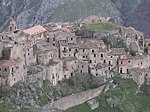Cilento
Cilento and Vallo di Diano National Park with the Archeological Sites of Paestum and Velia, and the Certosa di Padula | |
|---|---|
| Criteria | Cultural: (iii)(iv) |
| Reference | 842 |
| Inscription | 1998 (22nd Session) |
| Coordinates | 40°17′24″N 15°28′34″E / 40.290°N 15.476°E |

Cilento (Italian: [tʃi.len.to]) is an Italian geographical region of Campania in the central and southern part of the province of Salerno and an important tourist area of southern Italy.
Cilento is known as one of the centers of Mediterranean diet.
Geography
The coast of Cilento is located on the Tyrrhenian Sea, stretching from Paestum to the Gulf of Policastro, near the town of Sapri. Most of the touristic destinations in the coast are frazioni (hamlets) of comuni (municipalities) whose seats are inland; examples include Santa Maria di Castellabate, Acciaroli, Velia, Palinuro, Marina di Camerota, Scario and Policastro Bussentino.
The inner boundaries are the Alburni mountains and Vallo di Diano, sometimes considered as part of Cilentan geographical region, which has in Sala Consilina its largest center. The most important towns in this area are Vallo della Lucania (in the middle), Sapri and Agropoli: this is the largest town of Cilento and the principal harbour. Most of this area is included in "Cilento and Vallo di Diano National Park".
Inland communes
Moio Della Civitella
Seaside Communes
- Agropoli
- Ascea
- Camerota
- Capaccio
- Caprioli
- Casal Velino
- Castellabate
- Centola
- Montecorice
- Palinuro
- Pisciotta
- Pollica
- San Giovanni a Piro
- San Mauro Cilento
- Sapri
History
Greek colonies
The region is steeped in
]Cilento comes by the
Sixth province of Campania
In the 1990s it was proposed to make Cilento a new province of Campania.[2] This proposal has never come near to implementation; in particular there was the difficulty of choosing an administrative centre. The four candidates were Vallo della Lucania (in the most central position), Agropoli (the largest town, situated in the north), Sala Consilina (the most populous town of Vallo di Diano) and Sapri (in the centre of southern Cilento, with the most important railway station).[citation needed] Another more recent proposal was to move Cilento from Campania to Basilicata, as a third province[3] together with the existing provinces of Potenza and Matera.
The Cultural Pyramid
In 2020, the poet
National Park
In 1991,
Coast
The Cilentan Coast, or Costiera Cilentana in
Language
Cilento was part of ancient Lucania, and its language is influenced by Lucanian. In the north of Cilento the dialect is more influenced by Neapolitan, but in the south it has many similarities with Sicilian.
Cilento DOC
Red Cilento wines are a blend of 60-70%
Photogallery
-
Agropoli
-
Velia
-
Licosa island in the Comune of Castellabate
-
Paestum
-
Paestum
-
S.Maria di Castellabate
See also
- Cilento and Vallo di Diano National Park
- Vallo di Diano
- Velia("Elea")
- Paestum ("Poseidonia")
- Pruno Cilento
- Cilentan language
- Gulf of Salerno
- Agropoli
- Vallo della Lucania
- Sapri
- Sala Consilina
- Marina di Camerota
- Certosa di Padula (Padula)
- Cape Palinuro (Palinuro)
References
- ^ "Cis Alentum: The origin of the name "Cilento"". Archived from the original on September 22, 2018.
- ^ "Rassegna Stampa" [Press Review]. Il Mattino, www.oricchio.it. 14 November 2001. Retrieved 26 September 2022.
- ^ "L'area comprende il Vallo di Diano, il Cilento e il Golfo di Policastro «Via dalla Campania, entriamo in Basilicata»" [The area includes the Vallo di Diano, Cilento and the Gulf of Policastro "Via the Campania, let's enter Basilicata"]. Corriere della Sera (in Italian). Retrieved 26 September 2022.
- ^ "Scuola empatica: genesi e sviluppo" [Empathic school: genesis and development]. January 9, 2021. Retrieved 28 September 2022.
- ^ "Salento, sara' apposta "La Nuova Piramide Culturale Del Cilento"" [Salento, will be on purpose "The New Cultural Pyramid of Cilento"]. August 5, 2021. Retrieved 28 September 2022.
- ^ "'La Piramide Culturale del Cilento': Trentinara nel progetto di Menotti Lerro" ['The Cultural Pyramid of Cilento': Trentinara in the Menotti Lerro project]. StileTV. Retrieved 28 September 2022.
- ^ "Trentinara al centro del "Movimento Empatico"" [Trentinara at the center of the "Empathic Movement"]. November 2, 2021. Retrieved 28 September 2022.
- ^ "Trentinara: promuove il territorio, accordo con il Centro Contemporaneo delle Arti di Vallo" [Trentinara: promotes the territory, agreement with the Contemporary Arts Center of Vallo]. November 1, 2021. Retrieved 28 September 2022.
- ^ ISBN 1-55297-720-X.
Sources
- Maurizio Tortora: Cilientu mia. Edizione del Delfino, 1977, Naples
- Giuseppe Vallone: Dizionarietto etimologico del basso Cilento. Editore UPC, 2004
- Pietro Rossi: Ieri e oggi 1955-2005. Poesie in cilentano. Grafiche Erredue, 2005
- Barbara Schäfer: Limoncello mit Meerblick. Unterwegs an der Amalfiküste und im Cilento. Picus, 2007, ISBN 978-3-85452-924-8
- Peter Amann: Cilento aktiv mit Costa di Maratea - Aktivurlaub im ursprünglichen Süditalien. Mankau, 2007, ISBN 3-938396-08-3
- Peter Amann: Golf von Neapel, Kampanien, Cilento. Reise Know-How, 2006, ISBN 3-8317-1526-2
- Barbara Poggi: La Cucina Cilentana - Köstlichkeiten aus der Cilento-Küche. Mankau, 2006, ISBN 3-938396-02-4
- Luciano Pignataro: Le ricette del Cilento. Ed. Ippogrifo, 2007, ISBN 978-88-88986-43-2
- ISBN 978-8866445678
External links
- What to do and see in Cilento and Tourism in Cilento (in Italian)
- Cilento and Vallo di Diano National Park (in Italian and English)
- Historical and other infos about Cilento and Vallo di Diano National Park (in English)
- Cilento Photos (in English)
- Tourism in the National park of Cilento (in Italian)
- Tourism and holidays in Cilento (in Italian)
- Cilento Social Network (in Italian)











